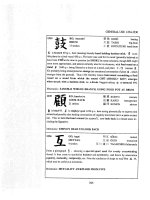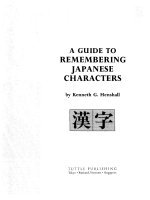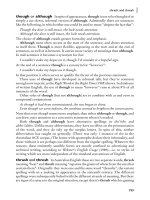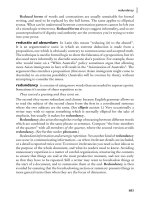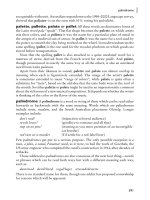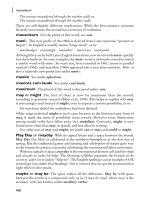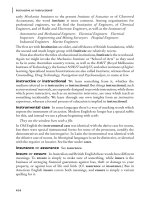The Cambridge Guide to Australian English Usage phần 1 ppt
Bạn đang xem bản rút gọn của tài liệu. Xem và tải ngay bản đầy đủ của tài liệu tại đây (3.81 MB, 94 trang )
This page intentionally left blank
The Cambridge Guide to
Australian English Usage
The Cambridge Guide
to Australian English
Usage
PAM PETERS
Macquarie University
CAMBRIDGE UNIVERSITY PRESS
Cambridge, New York, Melbourne, Madrid, Cape Town, Singapore, São Paulo
Cambridge University Press
The Edinburgh Building, Cambridge CB2 8RU, UK
First published in print format
ISBN-13 978-0-521-87821-0
ISBN-13 978-0-521-70242-3
ISBN-13 978-0-511-29496-9
© Pam Peters 2007
2007
Information on this title: www.cambridge.org/9780521878210
This publication is in copyright. Subject to statutory exception and to the provision of
relevant collective licensing agreements, no reproduction of any part may take place
without the written
p
ermission of Cambrid
g
e University Press.
ISBN-10 0-511-29496-4
ISBN-10 0-521-87821-7
ISBN-10 0-521-70242-9
Cambridge University Press has no responsibility for the persistence or accuracy of urls
for external or third-party internet websites referred to in this publication, and does not
g
uarantee that any content on such websites is, or will remain, accurate or a
pp
ro
p
riate.
Published in the United States of America by Cambridge University Press, New York
www.cambridge.org
hardback
paperback
paperback
eBook (EBL)
eBook (EBL)
hardback
Contents
Preface to The Cambridge Guide to Australian English Usage page vii
Preface to The Cambridge Australian English Style Guide ix
Foreword to The Cambridge Australian English Style Guide xiii
Overview of contents and how to access them xv
A to Z entries 1
Appendix I
International Phonetic Alphabet Symbols for Australian English Sounds 885
Appendix II
Perpetual Calendar 1900–2020 886
Appendix III
Geological Eras 888
Appendix IV
International System of Units (SI Units) 889
Appendix V
Interconversion Tables for Metric and Imperial Measures 892
Appendix VI
Selected Proofreading Marks 894
Appendix VII
Formats for Letters 896
Appendix VIII
Layout for Envelopes 898
Appendix IX
Formats for Email 899
Appendix X
Time Line for the English Language and Australian English 900
References 903
v
Preface to The Cambridge
Guide to Australian
English Usage
Since the first publication of The Cambridge Australian English Style Guide,
electronic communication has become almost universal, used in parallel to or instead
of print. Wordprocessors are now the primary means for drafting documents,
whether they are to appear in hard copy (i.e. on paper) or to be transmitted over
the internet. The new medium impacts on numerous aspects of language and style
which are reflected in updated entries in this new edition.
The internet itself provides access to great quantities of documents, through
which linguists gain a broader picture of Australian style and usage than ever
before. Data from Australian sources on the internet has been used to inform
the Cambridge Guide, to indicate the relative frequencies of alternative forms of
words. Additional corpus data comes from the Australian ICE corpus, containing
both spoken and written usage and from other recent corpora (see entry on English
language databases). The results of usage surveys conducted nationwide through
Australian Style from 1992 on are also used to shed light on the sociolinguistic
patterns of variation. Recently published research on Australian and other varieties
of English has been invoked to expand the frame of reference.
References to Australian secondary sources, dictionaries such as the Macquarie
Dictionary (2005) and style manuals (the Australian Government Style Manual
2002) have all been updated to the latest edition. Recent English grammars such as
the Longman Grammar (1999) andtheCambridgeGrammar (2002) have been cited
on points of usage. The latest editions of American and British style manuals, such
as the Chicago Manual (2003), New Hart’s Rules (2005) and Butcher’s Copy-editing
(2006) have also been referred to in this book. But references to world dictionaries
such as the Oxford English Dictionary (2nd ed. 1989) and Webster’s Third New
International Dictionary (revised ed. 1986) still stand, as we await their new editions.
With all these resources, this fully updated and freshly titled edition of the
Cambridge Guide keeps pace with changing elements of Australian English, and
empowers its readers to make fully informed decisions about language and style. I
am mostgrateful to Kate Indigo of Cambridge University Press(Melbourne) and to
editor Lee White for their professional assistance with the MS. To my own family,
John, Fliss and Greg, I owe the greatest thanks of all.
Pam Peters, Sydney 2006
vii
Preface to The Cambridge
Australian English Style Guide
If language stood still, there would be little need for new dictionaries or new guides
to style and usage.Buta living language needs to beaccountedforat regular intervals
as it responds to changing social, cultural and political circumstances.
Since World War II Australian English has emerged as a variety in its own right.
Instead of simply taking its linguistic cues from Britain, it now absorbs language
elements from North America as well and develops its own norms and standards. It
embraces more alternatives than hitherto, and The Cambridge Australian English
Style Guide aims to map this widened range of options in the 1990s—and to subject
the oldercanons of English usage tofresh scrutiny in the lightof modern linguistics.
The discipline of linguistics has added immensely to our understanding of the
dynamics of language and of the patterning within it. It emphasises the need to look
for evidence in assessing what is going on. The Cambridge Australian English Style
Guide looks for primary and/or secondary sources of information on the current
state of English wherever they are to be found, to ensure that the book represents
the full spectrum of usage, not just the perspective of an individual author.
The compilation of large computerised databases of contemporary English
provides us with new research tools for the study of usage. Statistics from the
recently completed ACE corpus (Australian Corpus of English) can be directly
compared with databases of American English (the Brown corpus) and British
English (the LOB or Lancaster-Oslo/Bergen corpus), to highlight divergences
between the three varieties of English. Each corpus has extracts from 500 different
publications in a variety of prose genres, and thus a broad sampling of style and
usage (see English language databases in the body of the book). Corpus evidence
takes up where the citation records of historical dictionaries, such as the Oxford
English Dictionary, Webster’s Dictionary, Australian National Dictionary and the
Macquarie Dictionary of New Words, leave off.
Secondary sources of information on English usage undoubtedly wield influence
on current language practices, and their preferences and judgements are also
discussed in examining the status of each variant. Some of the authorities referred
to in writing this book are large, up-to-date dictionaries such as the Macquarie
Dictionary, RandomHouse Dictionary, andthe Collins Dictionary, recent books on
usage such as the Reader’s Digest Right Word at the Right Time andMurray-Smith’s
Right Words, new grammars of English such as Halliday’s Introduction to
ix
Preface to the First Edition
Functional Grammar, Huddleston’s Introduction to the Grammar of English,
and the Comprehensive Grammar of English by Quirk, Greenbaum, Leech and
Svartvik. Because punctuation and the forms of words are affected by changing
editorial practices, reference has also been made to the most recent accounts of
editorial style, including the Australian Government Style Manual (4th ed.), Copy-
editing (3rd ed.) by Butcher, Hart’s Rules (39th ed.), and the Chicago Manual of
Style (13th ed.). The full titles of these and all references mentioned in the book are
to be found in Appendix X.
A third kind of information used in this book is that which comes direct from
users of the language, by surveying their preferences and practices when faced
with choices in usage and style. Elicitation tests conducted by researchers in
Britain such as Mittins, and Collins in Australia, help to show how people deal
with expressions whose status is ambivalent; and surveys of spelling preferences
conducted in association with Style Council and other professional bodies yield
information on how professional writers decide between alternatives.
With its broad range of sources, this book aims to provide a balanced and
thoroughly informed account of Australian style and usage on the threshold of
the twenty-first century. It steers a course between the extremes of prescription
and description, invoking both linguistic principle and the usage evidence available
when making recommendations. It sets itself apart from accounts of usage
which enshrine conservative traditions without reference to language principle
or practice, and it re-evaluates conventional notions of correctness case by case.
Many traditional judgements on “correctness” reflect the prelinguistic conception
of writing and literature as the only proper forms of language. A properly linguistic
account of usage must take account of the various levels and different genres of
language, written and spoken; and generic information from the ACE corpus and
others is presented in association with the statistics of usage.
The interaction between colloquial and formal idiom provides rich stylistic
resources for skilled writers to exploit. The Cambridge Australian English Style
Guide draws attention to writing technique and to writing style in many of its
entries. The book’s title is deliberately ambiguous in this sense, because the book is
concerned with both macro- and micro-aspects of style. Many entries begin with a
small detail of word form or meaning or punctuation, but in the end this connects
with broader issues of style, the tone in which the writer intends to communicate,
or the stance which s/he wishes to adopt. Formal and conventional aspects of style
are discussed, as in letter writing and reports, as well as more open-ended topics
such as argumentation, figures of speech and the rhythm of prose.
Apart from serving the needs of those who write, the Style Guide pinpoints
topics which are crucial to those who edit writing, whether for themselves or in
a professional capacity. The use of wordprocessors means that more people than
ever have to think about editorial matters and to decide on questions of style. The
freedom to create one’s own “house style” entails a need to know what the current
x
Preface to the First Edition
options are, whether one is dominant, what principles underlie the selection of
alternatives, and which would make for more consistent and easier implementation
overall. Where there are options as with traveller/traveler, the less frequent word
or word form may make good linguistic sense, and the fact that it is the “minor
variant” does not invalidate its use here. The tendency to elevate one variant over
others simply on the basis of tradition or strength of usage is stultifying, and to be
resisted by anyone who cares about the life of the language. Yet editors do have
to implement a single option in a given context, and editorial choices have been
made for this book which are indicated between ruled lines at the end of certain
entries. The choices made are not intended to disallow others however, and the
book supplies material on which alternative decisions can be based.
The Cambridge Australian English Style Guide is designed to support the
work of anyone who engages with written language in Australia. Professional
communicators, advertising copywriters and computer programmers all have to
decide on the forms of words by which to transmit information. Teachersof English
to native and nonnative students have to consider what they will present as the
norms of the language, to equip their students with the essentials as well as ensure
that their knowledgeis robust enough tocope with the vagariesofactual usage. (The
inclusion ofboth traditional and modern grammar terminology will enable teachers
to locate and describe elements of English.) And those members of the community
who reflect on language at their leisure should find stimulation in exploring the
finer points of Australian English.
The book owes much to several distinguished consultants: Graham Grayston,
formerly of the Australian Government Publishing Service, Alec Jones of the
University of Sydney, Stephen Knight of Simon de Montfort University and
formerly the University of Melbourne, and Colin Yallop of Macquarie University.
It has benefited by countless discussions with colleagues and friends in linguistics,
lexicography and the study of the English language: John Bernard, David Blair, Sue
Butler, Peter Collins, Tony Cousins, Peter Fries, Rhondda Fahey, Peter Peterson,
Diane Speed and Sue Spinks, among many. The support of Cambridge University
Press and Robin Derricourt is gratefully acknowledged. Above all The Cambridge
Australian English Style Guide owes its inspiration to Arthur Delbridge, emeritus
professor at Macquarie University, and its successful completion to John Peters,
my computer adviser and constant companion.
Pam Peters
xi
Foreword to The Cambridge
Australian English Style Guide
In both Australia and the United States of America, efforts to codify the national
language gathered strength about 200 years after the first European settlement.
The publication of Webster’s Dictionary in the USA and the Macquarie Dictionary
here—both of them comprehensive accounts of the standard regional variety of
English—was at that stage of national development; and they opened the field for
a florescence of dictionaries and other works on usage and style.
In Australia the shadow of Fowler (Modern EnglishUsage, OUP 1926, 1965) has
fallen benignly over the late Stephen Murray-Smith, whose Right Words (Viking
1987, 1989) offered genial and personal guidance on contemporary usage. At the
other end of the personality scale is the Style Manual for Authors, Editors and
Printers (Australian Government Publishing Service, 4th edition 1988) which is
now addressed not just to government writers, as formerly, but “to all those who
have occasion to write for a general audience”.
What then are the distinctive qualities of The Cambridge Australian English
Style Guide? For me, as an interested outsider, there are several:
r
Its author is not just an experienced writer, editor or publisher, expressing views
that are the fruit of personal experience and judgement; she is a scholar well
trained in the discipline of linguistics, who has done extensive research into the
history of written English in its major varieties; she has excellent grounding
and achievement in the languages that have contributed most to the history of
English—Latin, Old Norse, French, German etc. So she writes with an authority
that comes from a professional knowledge of language and languages.
r
Her principles of style guidance are founded on descriptive accounts of actual
language used in identifiable acts of written communication, in newspapers,
magazines, books of fiction and nonfiction, all assembled in computerised
databases here and elsewhere. Her guidance is not personal in origin, for the
reader is first given the facts about a particular variant usage, then taken through
the events that produced the variant, with grace, style and good humour in the
telling; and in the end the reader may decide which of the possible variants is
best for the work in hand.
r
Australian English is not presented in a vacuum, but compared with and related
to British, American and other varieties of English.
xiii
Foreword to the First Edition
r
The range of topics is exceptionally comprehensive, with ample cross-references
to give easy access to some thousands of individual language questions and
answers.
These things make it an altogether new type of style guide. Till now we have known
only the Fowler type; from now on the benchmark will be the Peters type, here
and (I suspect) internationally. So use it, enjoy it, and be proud of it!
Arthur Delbridge AO 1994
Consultants to The Cambridge Australian English Style Guide
GRAHAM GRAYSTON
Canberra; formerly Australian Government Publishing Service
ALEC JONES
Department of English, University of Sydney
STEPHEN KNIGHT
Department of English, Media and Cultural Studies, De Montfort University
COLIN YALLOP
Dictionary Research Centre, Macquarie University
xiv
Overview of Contents
and How to Access Them
The alphabetical list in this book contains two kinds of entries: those which deal with
general topics of language, editing and writing, and those dealing with particular
words, word sets or parts of words. An overview of the general entries is provided
on the following pages. Individual entries are too numerous to be shown there, but
they take their place in the alphabetical listing (ordered word by word rather than
letter by letter). For many questions, either general or particular entries would lead
you to the answer you’re seeking, and the book offers multiple access paths via
crossreferences.
Let’s say you are interested in where to put the full stop in relation to a final
bracket or parenthesis. Any ofthosetermswould take you to the relevant discussion
under brackets. In addition the general entry on punctuation presents a list of all
the entries dealing with individual punctuation marks.
Questions of grammar are accessible through traditional terms such as noun and
verb, clause and phrase, and traditional labels such as dangling participle or split
infinitive . . . though the entries may lead you on to newer linguistic topics such
as information focus and modality. Aspects of writing and argument (when is it
OK to use I? what does it mean to beg the question?) are discussed under their
particular headings, but can also be tracked down through more general ones such
as impersonal writing and argument.
If your question is about a word such as hopefully, or apair such asalternate and
alternative,orgourmet and gourmand, the discussion is to be found under those
headwords. When it’s a question of spelling, e.g. convener or convenor, the indiv-
idual entry may answer it, and/or direct you on to another (-er/-or) where a whole
set with the same variable part is dealt with. In the same way, the entry -ise/-ize
discusses the alternative spellings of countless verbs like recognise/recognize,
although there are too many to enter alphabetically. The key spelling entries are
listed under spelling sections 2 and 3, in case you’re unsure what heading to look
under. Alternative plural forms can be located via the entry on plurals.
As in the text above, the use of boldface means that the word is entered as a
headword, and it identifies all crossreferences at the end of entries. Within any
entry, further instances of the headword(s) are often boldfaced to draw attention
to strategic points. Words related to the headword(s) or derived from them are set
in italics, as are all examples.
xv
Overview of Contents and How to Access Them
Editorial style
Editoral technique
abbreviations
audiovisual and
electronic media
bibliographies
dating systems
indexing
lists
prelims
proofreading
referencing
titles
Inclusive language
Aboriginal
or Aborigine
disabled
half-caste
nonsexist language
racist language
Punctuation
brackets
apostrophe
colon
comma
dash
full stop
hyphen
question mark
quotation marks
semicolon
bullet points
Typography
accents
capital letters
dates
headings
indention
italics
numbers and number
style
lists
URL
ethnic
Style and structure of writing
Argument and
structure of
discourse
argument
begging the question
fallacies
heading structure
introduction
information focus
paragraph
topic sentence
Rhetorical devices
analogy
aphorism
figures of speech
irony
metaphor
oxymoron
personification
symbol
understatement
Varieties of
English
Australian English
American English
British English
Canadian English
International English
standard English
New Zealand English
Australian issues
Aboriginal words
americanisation
dialect
flash language
time zones
interstate differences
Special styles
commercialese
impersonal writing
email style
jargon
journalese
plain English
technologese
Writing forms
reports
summary
Commonwealth
town names
inverted pyramid
letter formats
narrative
online document
structure
coherence and
cohesion
deduction
xvi
Overview of Contents and How to Access Them
Words
Forms of words
affixes: prefixes, suffixes
acronyms and initialisms
compounds
clipping
backformation
hypocorisms
past tense forms
plurals, English and foreign
proper names
zero forms
contractions
Spelling
alternative spellings:
ae/e
i/y
-ise/-ize
-c/-ck
-ce/-ge
-e
-f/-v
Special
expressions
cliché
colloquialisms
four-letter words
foreign phrases
geographical names
intensifiers
scientific names
hedge words
Word meanings
and sense
relations
antonyms
euphemism
folk etymology
hyponyms
reciprocal words
synonyms
l/ll
oe
-or/-our
-re/-er
spelling rules:
-o
y>i
i before e
i>y
doubling of
final consonant
Grammar
Grammatical issues Word classes
dangling participles
double negatives
first person
gerunds and gerundives
modality
adjectives
adverbs
conjunctions
conjuncts
determiners
interjections
agreement
cleft sentence
collocation
nonfinite clauses
relative pronouns
restrictive relatives
split infinitives
stranded prepositions
subjunctive
verb phrase
"whom"
nouns
prepositions
pronouns
verbs
xvii

